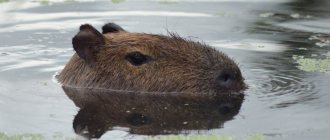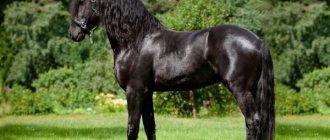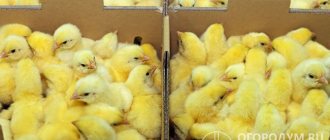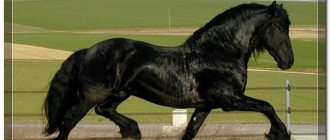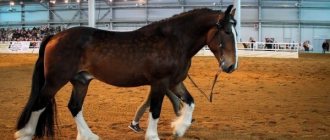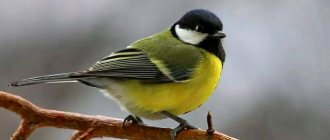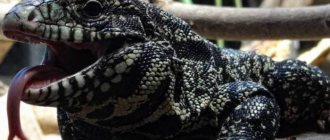Breeds of horses and ponies
Horse height - 156-160 cm
Horse color - red, brown, bay, bay-roan, black, and also red-roan
Exterior - horses of this breed have a small but proportional head, a convex profile, a short neck, a powerful chest, a long back, strong, strong and short limbs, and a rounded belly.
The coat is medium. This breed matures quickly, but is less resistant to disease than some other breeds.
Brief description of the breed
You can distinguish the Soviet heavy truck from other breeds by its massiveness and large build, which attract the gaze of others. Few horses can boast of such achievements and skills as this breed, which is capable of transporting loads weighing several tons. Since ancient times, horses have been used precisely for such purposes, to transport heavy carts.
The weight of one individual can reach tons; the height of the horse will be no higher than 170 cm to the level of the withers. The animal is characterized by a wide, powerful chest, a strong back and a clearly defined muscular neck. The head of the Soviet heavy truck is of medium proportional size, the nostrils are wide, and the cheeks are quite developed. On the top of the head sit medium-sized ears, sometimes they have a drooping shape. The neck gradually turns into a low-set withers, the animal’s back is soft, ideal for a saddle. The horse can withstand heavy loads thanks to its strong, level loin, and its slightly drooping croup has a forked shape. Muscular and at the same time dry limbs end in smooth, ideally shaped hooves.
The color and color of the Soviet draft horse can be different, most often red and a roan shade, less often bay with the same roan shade. The limbs are edged with moderately grown brushes, and the mane and tail show fullness and volume. By nature, such horses have a calm and kind disposition, but retain energy and strength. In general, the distinctive features of such an animal are short hips, large hocks, wide pasterns, with short pasterns and elongated shoulder blades.
Characteristics
Tall and muscular, horses of this species have a strong build. The weight of stallions is about 900 kg. Horses are distinguished by their massive body, wide chest, powerful legs and strong neck. Against their background, the horse's head looks small.
The color of the animals is predominantly red or bay; red-roan or bay-roan colors are possible.
In some cases, representatives of this breed have incorrect placement of the hind limbs. Such clubfoot does not affect the working qualities of the animal. However, for horses that participate in breeding work, incorrect placement of the hind legs can cause rejection and removal from breeding work.
Animals have a calm temperament. At the same time, horses are energetic and hardworking. Breeders note that animals of this breed cannot be called good-natured. This is explained by the focus of the breeding work. When breeding the breed, breeders sought to convey to the offspring the strength and endurance of the parents, and not their kindness and complaisance.
You might be interested in an article on the topic: Russian Trotter
History of the breed
The first appearance of such heavy-duty horses was recorded in the Western European powers of the 18th century; much later, Russian horse breeders began breeding the Soviet heavy-duty horse. To this day, the Soviet Heavy Truck breed is considered the most sought after and popular among such horses. This horse was able to glorify all horse breeders in Russia. Horses of such large size and power were bred within the Soviet Union, due to the Brabançons imported from Belgian horses after the 19th century. After that, the local mares, strong for work, were matched with the popular Belgian heavy trucks and received a new type - Soviet heavy trucks.
The greatest achievements in breeding this breed of horses deservedly go to I.A. Antsin and D.A. Kislovsky. — thoughts to successful livestock specialists in Russia. These two people did a colossal amount of work to breed a new powerful breed, which in the future would work for the benefit of Soviet people. Thanks to high intelligence and experienced selection, horse breeders were able to maximally improve the qualities and characteristics of horses with strong bones and impressive muscles with a fairly lean body constitution. And modern individuals have become much less whimsical in care and feeding.
The purpose of creating such a horse was simple - to help in agricultural work for transporting large loads. And in the middle of the 20th century, domestic stud farms produced the first improved stallions. In 1952, the Soviet heavy truck was approved at the state level, recognizing the horse as what Soviet management needed. Despite the fact that many of the noble skills and characteristics of the “progenitor” of the resulting Soviet draft horse were inherited by him, the new generation demonstrated a greater milk production rate of mares.
Purpose
The former purpose of heavy draft breeds - plowing, transporting cargo - is already in the past, and can rarely be found with the modern use of these horses. Today, outdoor recreation, tourism and sports are in fashion.
In equestrian tourism, draft horses have become very important and sought-after assistants. The calm and balanced nature of these strong horses allows even beginners who ride them for the first time to feel confident and calm on horseback. During active recreation, lovers of traveling on horseback will not find more durable and unpretentious assistants. Breeders and horse breeders have long valued heavy draft breeds for their heroic power and strong stature, which they pass on to their offspring.
A recent crossing of a heavy draft horse with a trotting mare produced a cross between a strong and fast horse highly appreciated by sports enthusiasts. It is also popular among hunters. Accurate execution of commands, balance and speed make these horses the best assistants who will not let you down in difficult times. They are not shy and trust their owner, which is the key to a successful relationship between man and horse.
Lifestyle in nature
In order to find an approach to a horse of this breed, you need to create comfortable living conditions for it and know what kind of care the animal needs.
Maintenance and care
The Soviet draft horse has no special preferences; it needs a spacious stable, a place for walking and free running, clean drinking and regular food. In order for a horse to work for the benefit of humans, the owner must take care of the health of the animal. Firstly, a properly formulated diet and feeding will help the horse maintain its energy and strength. Secondly, regular examination of the horse after a day of work will prevent the risk of diseases and injuries. And several times a year, the draft horse must be examined by a veterinarian, as well as undergo all routine vaccinations and vaccinations.
After an active pastime, the horse needs to clean the nostrils of sweat and dust, and also wash the hooves with a hose to relieve fatigue. The mane and tail should be washed 1-2 times a week using conditioner and combed with a natural brush. To prevent your hair from getting tangled, you can braid it.
Nutrition
A properly formulated diet for the Soviet heavy truck is the key to its strength and power, productivity and energy. Heavy trucks equally need feeding with fresh and dry vegetation, as well as cereal crops. Therefore, every day the horse needs to be given grass and grain, as well as clean water. In order for a young foal to fully grow and build muscle, it is necessary to periodically feed the animal with concentrates and vitamin supplements. Horses love sugar, sweet beets and carrots, as well as potatoes.
Character and habits
The Soviet heavy truck is famous for its certain phlegmatic nature and excellent disposition. And the energetic temperament allows the horse to work most productively in tandem with a person. In general, the temperament of Soviet heavy trucks is balanced, good-natured, unpretentious and calm. Horses easily make contact with new people, but require a respectful and gentle approach. Negative emotions and anger are not welcome in people; only the “carrot method” can induce diligence and diligence in a horse.
The use of Soviet heavy trucks
All the world's draft horses were originally created in times of manual labor and the prosperity of the agricultural industry. Therefore, the main goal of creating a heavy truck is to help people in agricultural work and transport heavy loads over long distances. Different countries have improved the resulting breeds with their own methods and views, but it is the Soviet heavy draft horse that can be considered one of the strongest and most seasoned horses in the world. The basis for any heavy draft horse was the Percheron, Shire, Clydesdale or Brabançon breed from Belgium.
Speaking of the Russian draft horse, such animals were used in the work of private yards and farmsteads, since such horses could cope with the most difficult tasks. And thanks to their calm disposition and easy-going nature, horses could easily find contact with small children. In those days, the Soviet Union held special competitions to identify the most powerful representatives of the Soviet Heavy Truck breed, and subsequently these leaders were sent to agriculture.
Today there is no great need for horses capable of pulling such ton loads. The mechanization of labor has changed stereotypes and priorities. Horses are increasingly raised in remote parts of the country from civilization for meat, as well as for yard work, logging and farm work.
Correct content
The Soviet heavy truck is a relatively unpretentious breed that does not require complex care. Individuals have a small stomach, so their nutrition consists of 4–8 daily meals. The diet includes barley, bran, oats, salt, and cake. For variety, hay from various herbs, raw carrots and beets are added to the food supply.
The arrangement of a stable for a heavy truck is standard: a feeding trough made of high-quality materials, lighting for 16 hours, straw bedding, and ventilation.
Proper horse care involves daily brushing, cleaning the feeder and drinking bowl. Inspecting hooves, teeth, and cleaning nostrils are important procedures. If symptoms of disease are detected, you should immediately contact your veterinarian.
The Soviet heavy truck is an amazing animal capable of transporting large loads. Keeping such a horse is beneficial both from an economic and economic point of view. Feeding does not require any special frills, care is standard. In response to care, the owner receives record results in work from the animal. Interest in the Soviet heavy truck is still relevant - horses are used to produce milk, meat and improve the characteristics of other breeds.
Interesting facts about these heavy trucks
To get to know the Soviet Heavy Truck breed better, you can familiarize yourself with the most unique information about these animals.
- The traction capabilities of one horse can be compared with the T-40 AM tractor. These horses can not only pull loads, but also work alongside machines in agriculture.
- For any individual of this breed it will not be difficult to move a load weighing 15 tons.
- In a 1957 competition in Tambov, a stallion named Force pulled a load weighing 23 tons along a distance of 23 meters.
- Soviet draft horses show high rates of growth and fertility.
Photo gallery
Handsome Soviet heavy truck
Soviet heavy truck on its hind legs
Soviet heavy truck in nature
Soviet heavy truck in winter
Character traits
Russian draft horses are not known for their violent temperament or excessive temperament. They are calm, rarely show character - ideal workhorses. The animals do not demonstrate particular friendliness, since during breeding there was no emphasis on this trait.
People are more interested in how much weight the Soviet heavyweight can lift than in his sociability and playfulness. But breeders who use horses for riding tourists or children, of course, select the most flexible individuals.
How much does a Soviet heavy truck cost?
Before purchasing such a noble horse of the Soviet Heavy Truck breed for personal use, you need to know the intricacies of such a transaction. The seller of animals must have documents from a veterinarian confirming the health status of the animal and vaccinations performed. In addition, a purebred horse must be accompanied by stud book records. The cost of such an animal depends on the area where they were produced, on the sex and age of the animal, as well as on its state of health.
One foal of the Soviet Heavy Truck breed will cost about 40,000 rubles. If an individual has reached the age of 1-1.5 years, the price for it will accordingly rise to 60,000 rubles. A full-fledged mare of this breed will cost the new owner from 80,000 to 100,000 rubles.
Productivity
The fertility rate of a horse of this species is average, it is 50-75%. However, mares of this breed are characterized by a high milk production rate. During the lactation period, more than 3,000 liters of milk can be obtained from an animal, and record figures reach 6,000 liters. The rapid growth of young animals is also an advantage of Soviet heavy trucks and makes the breed suitable for meat breeding.
Feeding on mother's milk, the foal gains 2 kg in weight every day. At six months of age, the animal already weighs 500 kg.
Representatives of this species can be involved in heavy work from the age of 2.5 years. Mares begin to be used for reproduction from the age of 3 years. The animal is capable of producing offspring up to 17 years of age. Also, Soviet heavy trucks are used to improve the local horse population. Young animals of the first generation inherit from the stallion larger sizes and good working qualities of the breed.
Soviet heavy truck today
Until 1990, the Soviet Heavy Truck horse breed was carefully studied and improved. To achieve this, the best representatives of this breed took part in competitions and tests, competitions and city exhibitions. But after the collapse of the USSR, it was not the most favorable period for such animals.
Today, the demand for such a horse has stabilized; many horse breeders and farmers in Europe dream of it. In addition, due to the shortage and high prices of fuel, many domestic businesses are resorting to the help of Soviet heavy trucks.
Feeding
draft food should be nutritious,
satisfying
, enriched with vitamins and minerals.
that without
harm to their health.
performance and goodness, add the following to the daily diet of the artiodactyl:
- grain (oats, barley) - up to 5.5 kg;
- fortified concentrated food - 1.8 kg;
- dry grass - 6–7 kg;
- succulent food, greenery - up to 2.5 kg;
- finely crushed straw - up to 1 kg.
In addition, the horse must be given fresh root vegetables: beets, carrots. The ideal summer nutrition is a combination of fresh pasture grass with concentrates. Salt is an essential product in the diet of heavy trucks.
However, it is necessary to remember the following: horses of this breed must not be overfed, since systematic overeating can lead to inflammatory processes in the hooves and dehydration. This reduces the performance of horses to zero.


